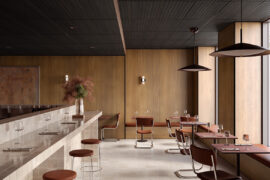The World Green Building Council (WorldGBC)* and Australia’s leading organisation working towards building sustainable communities – the Cooperative Research Centre for Low Carbon Living (CRCLCL) – have signed a memorandum of understanding (MOU) to take a global step towards defining ‘low’ to ‘no’ carbon cities in our world.
The World Green Building Council (WorldGBC)* and Australia’s leading organisation working towards building sustainable communities – the Cooperative Research Centre for Low Carbon Living (CRCLCL) – have signed a memorandum of understanding (MOU) to take a global step towards defining ‘low’ to ‘no’ carbon cities in our world.
September 22nd, 2014
The three year CRCLCL ‘Closing the Loop’ project – supported by leading industry partners Brookfield Multiplex, HASSELL and AECOM – will connect a wealth of existing evidence with frontend decision makers through better business case analysis, professional education, practical tools and guidelines. “’Closing the Loop’ will help global industries create built environments to positively impact people’s health, wellbeing and productivity whilst improving the building industry’s environmental performance,” CRCL Chief
Executive Officer, Scientia Professor Deo Prasad AO, said of the signing. “Collaborating with the World Green Building Council provides our project team with a unique opportunity to tap into the global leadership and significant knowledge that already exists throughout the world, thanks to the Council.”
The WorldGBC will support the CRCLCL by designating staff to help coordinate the project, opening an ongoing dialogue with the CRC, identifying overlaps and areas for future collaboration. This will provide information for reports, materials and promoting collateral within the global building community. ‘Closing the Loop’ members have been involved in WorldGBC’s ‘Health Wellbeing and Productivity in Offices’ report, through participation in the project Technical Committee and providing ongoing dialogue, content review and feedback on proposed metrics, whilst helping to promote the report’s findings.
“With up to 90 per cent of a company’s costs spent on salaries and benefits, even modest improvements to staff health and productivity can have a dramatic impact on organisational profitability. ‘Closing the Loop’ will enhance our understanding of the health, wellbeing and productivity implications of building design so that we can create environments that positively encourage health and wellbeing and stimulate productivity,” the WorldGBC’s Chief Executive, Jane Henley concluded.
*The World Green Building Council
The World Green Building Council connects a global coalition of more than 100 national Green Building Councils and their 27,000 member companies with a single mission: to transform the building industry and ensure our buildings and cities are healthy, efficient, productive and
sustainable.
About the CRC for Low Carbon Living Ltd
The CRC for Low Carbon Living (CRCLCL) is a national research and innovation hub that supports Australian industry to be globally competitive in the low carbon built environment sector. It brings together property, planning, engineering and policy organisations with leading Australian researchers. CRCLCL develops new social, technological and policy tools for reducing greenhouse gas emissions in the built environment. A key aim of the CRCLCL is to help cut Australia’s residential and commercial carbon emissions by 10 mega tonnes by 2020, which is the environmental equivalent of taking 2.3 million cars off the road each year. This will be achieved through developing low carbon building construction materials and increasing the evidence base for government policy and planning, among other measures. Australia has set greenhouse gas emissions reduction targets of 25 per cent by 2020 and 80 per cent by 2050 compared with 2000 levels. When the 2020 carbon reduction targets are met, the CRCLCL will have delivered a direct benefit of $250 million per year to the economy, while reducing risk to the $150 billion per year construction industry as it adjusts to a carbon-constrained economy.
Ultimately the CRCCLC will help unlock barriers to cost-effective carbon reduction opportunities, empower communities and facilitate the widespread adoption of integrated renewable energy. This will enable the sector to transition and contribute to Australia’s greenhouse gas emissions targets while maintaining industry competitiveness and improving quality of life. It is supported by the Cooperative Research Centres program, an Australian Government initiative.
LOW CARBON LIVING LTD
lowcarbonlivingcrc.com.au
WorldGBC
worldgbc.org
INDESIGN is on instagram
Follow @indesignlive
A searchable and comprehensive guide for specifying leading products and their suppliers
Keep up to date with the latest and greatest from our industry BFF's!

For Aidan Mawhinney, the secret ingredient to Living Edge’s success “comes down to people, product and place.” As the brand celebrates a significant 25-year milestone, it’s that commitment to authentic, sustainable design – and the people behind it all – that continues to anchor its legacy.

Zenith have reimagined a favourite collection for a workplace range that is informed by residential design
The HÅG Conventio Wing is a dynamic and stylish chair that has been designed specially for meetings and conferences. The lightweight design and the ability to be stacked up to 10 high make this chair the ideal general purpose chair for conferences, schools, meetings, libraries, cafes and hotels. The convention wing has been designed with […]
The internet never sleeps! Here's the stuff you might have missed

Australian designed and manufactured, Laminex Architectural Panels transform timber design aesthetics with cutting-edge technology

Despite its long and rich history, signwriting is a profession in decline. Will Lynes’ new show, Oily Water at Canberra Glassworks, aims to showcase the techniques of the trade to highlight its potential in design.